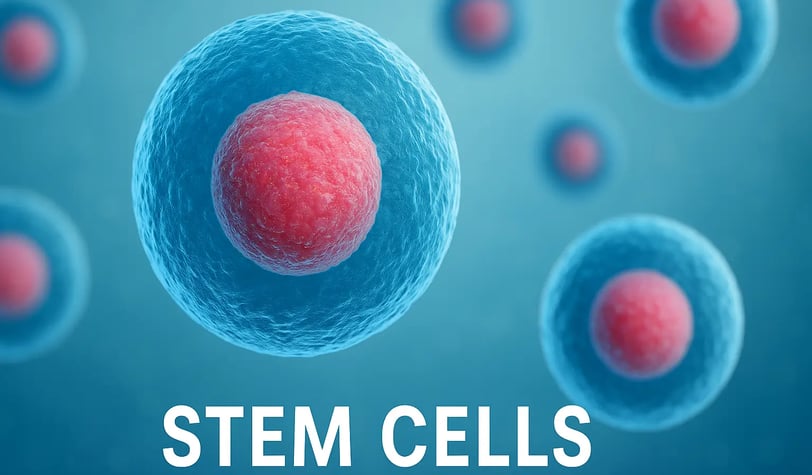What Are Stem Cells? Types, Medical Uses & Ethical Concerns Explained
Discover what stem cells are, their types, how they’re used in regenerative medicine, and the ethical debates surrounding stem cell research. Learn everything in this in-depth guide.


Introduction: What Are Stem Cells?
Stem cells are extraordinary cells in the human body that can transform into many different cell types. Unlike regular cells, stem cells have two defining abilities: self-renewal (they can replicate endlessly) and differentiation (they can become specialized cells like muscle, nerve, or blood cells). These unique properties make them invaluable for growth, tissue repair, and medical research.
Stem cells are categorized based on their potency:
Pluripotent stem cells can become almost any cell in the body.
Multipotent stem cells can turn into a limited range of cells within a specific lineage.
From early embryonic development to adulthood, stem cells continue to play a vital role in healing and regeneration.
Types of Stem Cells
Understanding the types of stem cells is crucial to appreciating their medical value and applications in research.
1. Embryonic Stem Cells (ESCs)
Derived from early-stage embryos, ESCs are pluripotent, meaning they can develop into nearly any cell type in the body. Their wide-ranging regenerative potential makes them valuable for treating diseases like:
Parkinson’s disease
Spinal cord injuries
Heart disease
However, ethical concerns arise due to the destruction of embryos during extraction.
2. Adult Stem Cells (Somatic Stem Cells)
Found in various body tissues such as bone marrow and skin, these multipotent stem cells can differentiate only into certain cell types. For example:
Hematopoietic stem cells in bone marrow can produce all types of blood cells.
Mesenchymal stem cells can form bone, cartilage, and fat cells.
They are widely used in medical treatments, especially bone marrow transplants.
3. Induced Pluripotent Stem Cells (iPSCs)
iPSCs are adult cells that have been genetically reprogrammed to act like embryonic stem cells. They share pluripotency without the ethical concerns of ESCs. iPSCs offer a path to personalized medicine and disease modeling, advancing research without using embryos.
Medical Applications of Stem Cells
Stem cells are revolutionizing modern medicine. Their regenerative capabilities are being harnessed for a variety of conditions, such as:
1. Regenerative Medicine
Stem cell therapy is used to regenerate or repair damaged tissues and organs. For instance:
Neural stem cells are used to restore function in spinal cord injury patients.
Cardiac stem cells are being tested for repairing heart tissue after a heart attack.
2. Cancer Treatment
Stem cells help rebuild the body after intensive treatments like chemotherapy. Hematopoietic stem cell transplantation is a common procedure used for:
Leukemia
Lymphoma
Multiple myeloma
3. Treatment of Degenerative Diseases
Stem cells are being researched for treating:
Parkinson’s disease
Type 1 diabetes
Alzheimer’s disease
They have the potential to generate neurons, insulin-producing beta cells, and more.
Ethical Issues in Stem Cell Research
The promise of stem cells comes with complex ethical questions, particularly surrounding embryonic stem cells.
Arguments in Favor:
Potential to cure severe and life-threatening diseases
Embryos used are often leftover from IVF and donated with consent
Arguments Against:
Belief that destroying embryos is equivalent to ending a potential human life
Religious and cultural values vary, complicating consensus
Legal & Regulatory Landscape:
Policies on stem cell research differ by country. For example:
The United States allows limited federal funding for embryonic stem cell research.
Other countries may impose stricter or more lenient laws depending on public opinion and ethical stance.
Conclusion
Stem cells hold incredible promise for transforming medicine and improving countless lives. As research advances, balancing the scientific potential with ethical responsibility will be crucial. From cancer treatment to regenerative therapies, stem cells continue to shape the future of modern healthcare.
Frequently asked questions
1. What are stem cells used for?
Stem cells are used for tissue regeneration, treating blood disorders, spinal cord injuries, and developing new drugs.
4. Can stem cells cure diseases?
While stem cells are not a “cure” yet, they offer promising treatments for diseases like Parkinson’s, diabetes, and cancer.
2. Are stem cell treatments safe?
Some stem cell therapies are FDA-approved and widely practiced, like bone marrow transplants. Others are still in clinical trials and should be approached with caution.
5. What’s the difference between pluripotent and multipotent stem cells?
Pluripotent stem cells can become any cell type; multipotent stem cells can only become certain types of cells related to their tissue origin.
3. What are the ethical concerns with stem cell research?
Most concerns revolve around embryonic stem cells, as extracting them destroys embryos. Alternatives like iPSCs help bypass these ethical issues.
